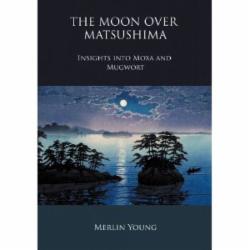"The Moon over Matsushima - Insights into Moxa and Mugwort"

"What are the secrets of mugwort and
moxibustion? This book will be your guide."
Lorraine Wilcox.
The Moon Over Matsushima sets out on a journey of exploration, one with unexpected twists and turns. It adds up to much more than a standard or run-of-the-mill acumoxa text, its unusual approach subtly stitching together motifs which take it outside the conventions of most books in the genre.
"This is a unique book. A breathtaking vista of information and perspectives."
Stephen Birch.
Two themes resonate throughout the text: the idea that moxibustion was and still is under-estimated as a treatment modality - since the first true formalized developments of Chinese medicine in the Han Dynasty but especially so today; and the second is that it was and may still be an effective therapy for the common man.
One theme is the Moxafrica Project (the astonishing investigation of moxa's possible role in the battle to contain drug-resistant TB in Africa) and the other is the compelling travelogue and seventeen-syllable haikus of Japan's master poet, Matsuo Basho. They make for an unlikely but enlightening polyphonic combination - and an unexpectedly enjoyable and informative read.
"If you are interested in moxa you will find the Moon over Matsushima a fascinating read and understand moxa in a new light"
Charles Chace
The book itself shifts systematically through five parts, the title of each reflecting parts of the mugwort plant itself. "The Roots" speculatively deliberates on the history of the treatment, at times a little playfully, but always with respect. "The Stalk" explores the nature and biochemistry of mugwort. "The Branch" reviews various traditional approaches as well as offering some slightly novel takes on them. "The Stem" takes an often hard-nosed analytical look at the therapy’s possible mechanisms particularly in the light on its well-accepted effect on immune response. "The Leaves" completes the main text by reviewing the therapy in the light of how it might be adapted for best use today.
An invaluable appendix contains over thirty pages of clinical treatments.
The work particularly focuses on Japanese moxibustion techniques and approaches. This focus is validated by the fact that, despite moxibustion having been taken to unique levels in Japan, these approaches have previously been largely ignored in the literature on the subject in the English-speaking world.
"Meticulously researched, timely and thought provoking - a salient work and a must read for any acupuncturist."
Todd Howard
Lorraine Wilcox.
The Moon Over Matsushima sets out on a journey of exploration, one with unexpected twists and turns. It adds up to much more than a standard or run-of-the-mill acumoxa text, its unusual approach subtly stitching together motifs which take it outside the conventions of most books in the genre.
"This is a unique book. A breathtaking vista of information and perspectives."
Stephen Birch.
Two themes resonate throughout the text: the idea that moxibustion was and still is under-estimated as a treatment modality - since the first true formalized developments of Chinese medicine in the Han Dynasty but especially so today; and the second is that it was and may still be an effective therapy for the common man.
One theme is the Moxafrica Project (the astonishing investigation of moxa's possible role in the battle to contain drug-resistant TB in Africa) and the other is the compelling travelogue and seventeen-syllable haikus of Japan's master poet, Matsuo Basho. They make for an unlikely but enlightening polyphonic combination - and an unexpectedly enjoyable and informative read.
"If you are interested in moxa you will find the Moon over Matsushima a fascinating read and understand moxa in a new light"
Charles Chace
The book itself shifts systematically through five parts, the title of each reflecting parts of the mugwort plant itself. "The Roots" speculatively deliberates on the history of the treatment, at times a little playfully, but always with respect. "The Stalk" explores the nature and biochemistry of mugwort. "The Branch" reviews various traditional approaches as well as offering some slightly novel takes on them. "The Stem" takes an often hard-nosed analytical look at the therapy’s possible mechanisms particularly in the light on its well-accepted effect on immune response. "The Leaves" completes the main text by reviewing the therapy in the light of how it might be adapted for best use today.
An invaluable appendix contains over thirty pages of clinical treatments.
The work particularly focuses on Japanese moxibustion techniques and approaches. This focus is validated by the fact that, despite moxibustion having been taken to unique levels in Japan, these approaches have previously been largely ignored in the literature on the subject in the English-speaking world.
"Meticulously researched, timely and thought provoking - a salient work and a must read for any acupuncturist."
Todd Howard
The book can be bought direct from Godiva Books, or from Amazon here. In Australia it can be purchased from China Books.